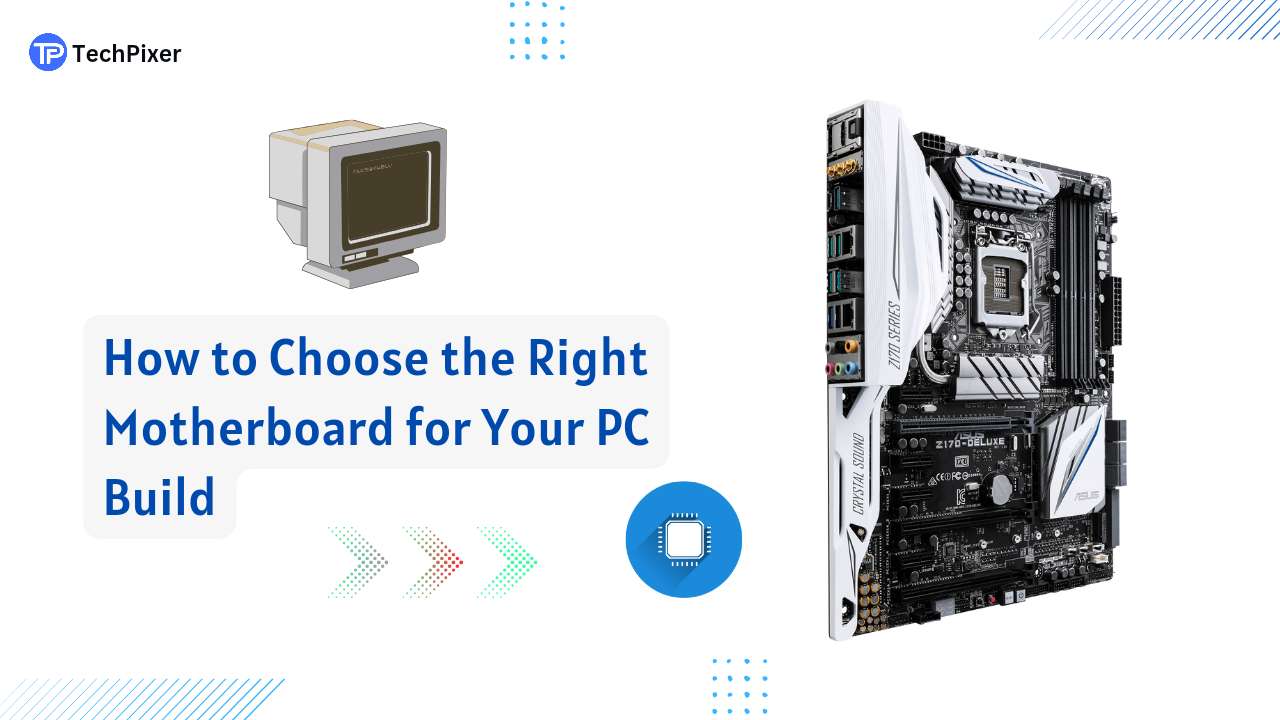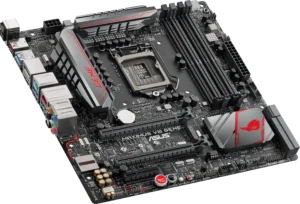Building together your own PC is an exciting challenge. Choosing a motherboard that works with your system is a crucial decision. The motherboard is what holds your machine together. It enables communication between all of the parts by connecting them. You’re in the right place if you want to know how to choose the best motherboard! This guide will walk you by means of the whole thing you must think about so that your can make a smart choice lacking getting too complicated.
What is a Motherboard?
Before we explore into the nitty-gritty of motherboard selection, let’s clarify what a motherboard actually is. . Picture it as the central hub or the command center of your PC. It’s a large circuit board that holds everything together – your CPU, RAM, storage, and more!
Key Functions of a Motherboard
The motherboard performs several crucial functions:
- Connections: It allows communication between different components.
- Power Distribution: It distributes power from the power supply to various parts.
- Data Transfer: It manages data flow between the processor, memory, and storage devices.
Types of Motherboard
Motherboards exist in various shapes and sizes, known as form factors. Here are the most popular ones:
ATX Motherboards
ATX (Advanced Technology eXtended) motherboards are the standard at the present. They give adequate space for components, many expansions slots, and are perfect for gaming projects. If you’re searching for room to grow, these are the way to go.
Micro ATX Motherboards
Micro ATX is a more compact version, striking a balance between size and expandability. They’re excellent for budget builds since they still offer decent features without taking up too much space.
Mini ITX Motherboards
For those who crave compactness or are building a home theater PC (HTPC), Mini ITX motherboards are the perfect fit. They can fit into small cases, but you’ll sacrifice features and upgrade potential. Choose wisely!
Key Specifications to Consider
Now that we’ve got the categories down, let’s dive further into what actually contributes when selecting your motherboard.
Socket Compatibility
The first thing you need to check out is the CPU socket. Your motherboard must have a socket that is suitable with your chosen processor. Intel and AMD have multiple socket types, and even within each brand, they change between generations.
Chipset Functionality
The chipset plays a key part in the motherboard’s capabilities. Want overclocking features? Need additional PCIe lanes? Different chipsets offer different features, so knowing what you need can help cut down your choices.
RAM Slots and Memory Support
While we’re on the topic of memory, you’ll want to determine the total number of RAM slots and the maximum amount of RAM your motherboard can handle. More slots mean additional upgrade options, and different motherboards support different RAM speeds.
Form Factor: What You Need to Know
Size Matters: How It Affects Your Build
Aside from the motherboard type, the form factor (ATX, Micro ATX, Mini ITX) carries weight in not just usability, but compatibility with your case. Check your case size and make sure the motherboard fits like a glove!
Cooling Solutions and Space Configuration
When considering the form factor, think about airflow and component layout. Will there be space for your cooling solutions? More powerful CPUs generate more heat, so having real estate for effective cooling is essential.
Expansion Slots: Planning for the Future
PCIe Slots Explained
Expansion slots are your ticket to flexibility. A good motherboard should have multiple PCIe slots for GPUs, sound cards, and more. It’s like giving your PC a personality; choose wisely based on what you envision for upgrades.
GPU Compatibility
If you’re gaming or doing graphic-intensive jobs, confirm your motherboard supports your desired GPU model. You don’t want to acquire a high-end graphics card just to find it doesn’t fit with your chosen motherboard!
Storage Options and Configuration
SSD vs. HDD
When it comes to storage, you’ll be divided between SSDs and standard HDDs. SSDs are faster, but more expensive, whereas HDDs are budget-friendly yet slower. Look for motherboards that accept both types efficiently.
M.2 and SATA Connections
Make sure your motherboard has enough M.2 and SATA connectors based on your storage demands. M.2 is the new wave of SSD storage, allowing quicker data transfer compared to standard SATA connections.
I/O Ports: Connectivity Is Key
USB Ports: Types and Layout
In the modern world, connectivity is important! Check how many USB ports are accessible and the types (USB-A, USB-C, etc.). Adequate ports allow you to attach your favorite peripheral devices without effort.
Audio and Network Ports
Also, don’t skip checking audio and networking ports! Integrated sound cards and the type of LAN or Wi-Fi connections can dramatically affect your user experience.
Budgeting for Your Motherboard
Finding the Right Balance
Your budget will absolutely impact your motherboard decision. While it’s tempting to invest on features you may never use, remember that there are great solutions out there that won’t break the bank.
Cost vs. Features Trade-offs
Investing in the correct features may cost a bit more initially but could save you from troubles down the way. Weigh your options and think long-term!
Brand Considerations
Popular Brands in the Market
There are various trustworthy motherboard brands out there. ASUS, MSI, Gigabyte, and ASRock are known for their quality and reliability. Choose a brand that interacts with you!
Warranty and Customer Support
Look for solutions that offer reasonable warranties and excellent customer support. This could be a lifesaver down the line if something goes wrong!
User Reviews and Benchmarks
Why They Matter
Don’t skip on reading customer reviews! Actual feedback can provide insight into any peculiarities or faults that might come with the motherboard you’re eyeing.
How to Interpret Them
Learning how to interpret the benchmarks is essential too. It’s a bit like doing your homework. Check if your motherboard performs well in the categories important to you.
Future Proofing Your Build
Planning for Upgrades
Motherboards can be a significant investment, and you want to ensure they last. Look for options that accommodate future upgrades in the CPU and RAM department.
Technologies to Look Out For
Keep an eye out for emerging technologies when making your choice. Features like PCIe 4.0 support may seem trivial now, but they can make a difference in your system’s longevity.
Installation and Compatibility Checks
Ensuring Everything Fits
Once you’ve made your choice, ensure all your components mesh well together. There’s nothing worse than realizing you have compatibility issues after you’ve unboxed everything!
Troubleshooting Common Issues
Be prepared for some troubleshooting during the installation process. It’s fairly uncommon to experience a few glitches along the way, but patience is crucial!
Read More : Intel Core i7 9750H CPU: Experience the Gaming Evolution!
Conclusion
Choosing the right motherboard is as crucial as selecting any other component in your PC build. so select a motherboard that resonates with your personal needs and gaming or computing ambitions. From form factor to compatibility with your CPU and RAM, every little detail counts! Take your time, do some research, and don’t hesitate to invest in a motherboard that matches your demands today and for the future.
Remember, creating a PC should be an enjoyable effort, not a stressful one. So take a big breath, feel thrilled about your build, and let’s get started!
Frequently Asked Questions (FAQs)
Here are some frequently asked questions about motherboard:
What is the most important feature of a motherboard?
The most crucial feature is compatibility with your CPU; without the right socket, your system doesn't even boot!
How do I know if the motherboard fits my case?
Check the form factor (ATX, Micro ATX, Mini ITX) and match it with your case specifications.
How long do motherboards typically last?
With proper care and compatibility with your components, motherboards can last many years, often 5-10 years.
What if I want to upgrade my PC later?
Look for motherboards that offer expansion slots and support for emerging technology. This will assist ensure you can upgrade easily.
How can I ensure my motherboard lasts long?
Choose a reputable brand, opt for high-quality components (especially VRMs), and consider a model with features that support future technology.

